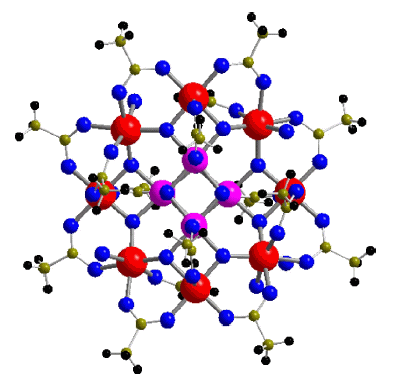Research
Highlights 2004
 Stephan Heer, Karsten Kömpe, Hans-Ulrich Güdel and Markus Haase
Stephan Heer, Karsten Kömpe, Hans-Ulrich Güdel and Markus Haase
Highly Efficient Multicolour Upconversion Emission in Transparent Colloids of Lanthanide-Doped NaYF4 Nanocrystals
Adv. Mater. 16, 2102-2105 (2004)
![]()
![]()
![]()
Abstract:
(Article without Abstract)
Graphical Abstract:
Highly efficient photon upconversion in solution is demonstrated for
the first time. Transparent colloidal solutions of Yb/Er and Yb/Tm doped
NaYF4 nanocrystals show bright upconversion emission in the red,
green, and blue spectral region by excitation around
1 mm with a laser of moderate
power. These new systems show a substantial improvement on the
order of 108 compared to previously reported systems.
Inside Front Cover Picture:
A synthesis route to lanthanide-doped NaYF4 nanocrystals, an important new
class of materials showing efficient multicolor upconversion emission in
transparent colloidal solution, is reported.
Solutions of Yb/Er- and Yb/Tm-doped NaYF4 nanocrystals show bright
upconversion emission in the red, green, and blue spectral region after excitation
with a laser of moderate power. These new systems show a substantial improvement
on the order of 108 compared to previously reported systems.
 G. Chaboussant, A. Sieber, S. Ochsenbein, H.-U. Güdel, M. Murrie, A. Honecker, N. Fukushima and B. Normand
G. Chaboussant, A. Sieber, S. Ochsenbein, H.-U. Güdel, M. Murrie, A. Honecker, N. Fukushima and B. Normand
Exchange interactions and high-energy spin states in Mn12-acetate
Phys. Rev. B 70, 104422/1-16 (2004)
![]()
![]()
Abstract:
We perform inelastic neutron scattering measurements on the molecular
nanomagnet Mn12-acetate to measure the excitation spectrum
up to 45 meV (500 K). We isolate magnetic excitations in two groups
at 5–6.5 meV (60–75 K) and 8–10.5 meV (95–120 K), with higher
levels appearing only at 27 meV (310 K) and 31 meV (360 K).
From a detailed characterization of the transition peaks we show that
all of the low-energy modes appear to be separate S = 9
excitations above the S = 10 ground state, with the peak at
27 meV (310 K) corresponding to the first S = 11 excitation. We
consider a general model for the four exchange interaction parameters
of the molecule. The static susceptibility is computed by
high-temperature series expansion and the energy spectrum, matrix
elements, and ground-state spin configuration by exact
diagonalization. The theoretical results are matched with
experimental observation by inclusion of cluster anisotropy parameters,
revealing strong constraints on possible parameter sets. We conclude
that only a model with dominant exchange couplings
J1 ![]() J2
J2 ![]() 5.5 meV (65 K) and small
couplings J3
5.5 meV (65 K) and small
couplings J3 ![]() J4
J4
![]() 0.6 meV (7 K)
is consistent with the experimental data.
0.6 meV (7 K)
is consistent with the experimental data.
 Colette Boskovic, Andreas Sieber, Grégory Chaboussant, Hans U. Güdel, Jürgen Ensling, Wolfgang Wernsdorfer,
Antonia Neels, Gael Labat, Helen Stoeckli-Evans and Stefan Janssen
Colette Boskovic, Andreas Sieber, Grégory Chaboussant, Hans U. Güdel, Jürgen Ensling, Wolfgang Wernsdorfer,
Antonia Neels, Gael Labat, Helen Stoeckli-Evans and Stefan Janssen
Synthesis and Characterization of a New Family of Bi-, Tri-, Tetra-, and Pentanuclear Ferric Complexes
Inorg. Chem. 43, 5053-5068 (2004)
![]()
![]()
![]()
![]()
Abstract:
Nine members of a new family of polynuclear ferric complexes have been
synthesized and characterized. The reaction of Fe(O2CMe)2
with polydentate Schiff base proligands (H2L) derived from
salicylidene-2-ethanolamine, followed in some cases by reaction with carboxylic
acids, has afforded new complexes of general formulas
[Fe2(pic)2(L)2] (where pic– is the
anion of 2-picolinic acid),
[Fe3(O2CMe)3(L)3],
[Fe4(OR)2(O2CMe)2(L)4],
and [Fe5O(OH)(O2CR)4(L)4]. The tri-,
tetra-, and pentanuclear complexes all possess unusual structures and novel core
topologies. Mössbauer spectroscopy confirms the presence of high-spin ferric
centers in the tri- and pentanuclear complexes. Variable-temperature magnetic
measurements suggest spin ground states of S = 0, 1/2, 0, and 5/2 for the
bi-, tri-, tetra-, and pentanuclear complexes, respectively. Fits of the
magnetic susceptibility data have provided the magnitude of the exclusively
antiferromagnetic exchange interactions. In addition, an easy-axis-type magnetic
anisotropy has been observed for the pentanuclear complexes, with D
values of approximately -0.4 cm–1 determined from modeling
the low-temperature magnetization data. A low-temperature micro-SQUID study of
one of the pentanuclear complexes reveals magnetization hysteresis at nonzero
field. This is attributed to an anisotropy-induced energy barrier to
magnetization reversal that is of molecular origin. Finally, an inelastic
neutron scattering study of one of the trinuclear complexes has revealed that
the magnetic behavior arises from two distinct species.
![]() Full Text PDF-Files are only accessible from within the University of Bern
Full Text PDF-Files are only accessible from within the University of Bern